CHEVROLET CAVALIER 1998 3.G Owners Manual
Manufacturer: CHEVROLET, Model Year: 1998, Model line: CAVALIER, Model: CHEVROLET CAVALIER 1998 3.GPages: 400, PDF Size: 20.74 MB
Page 311 of 400
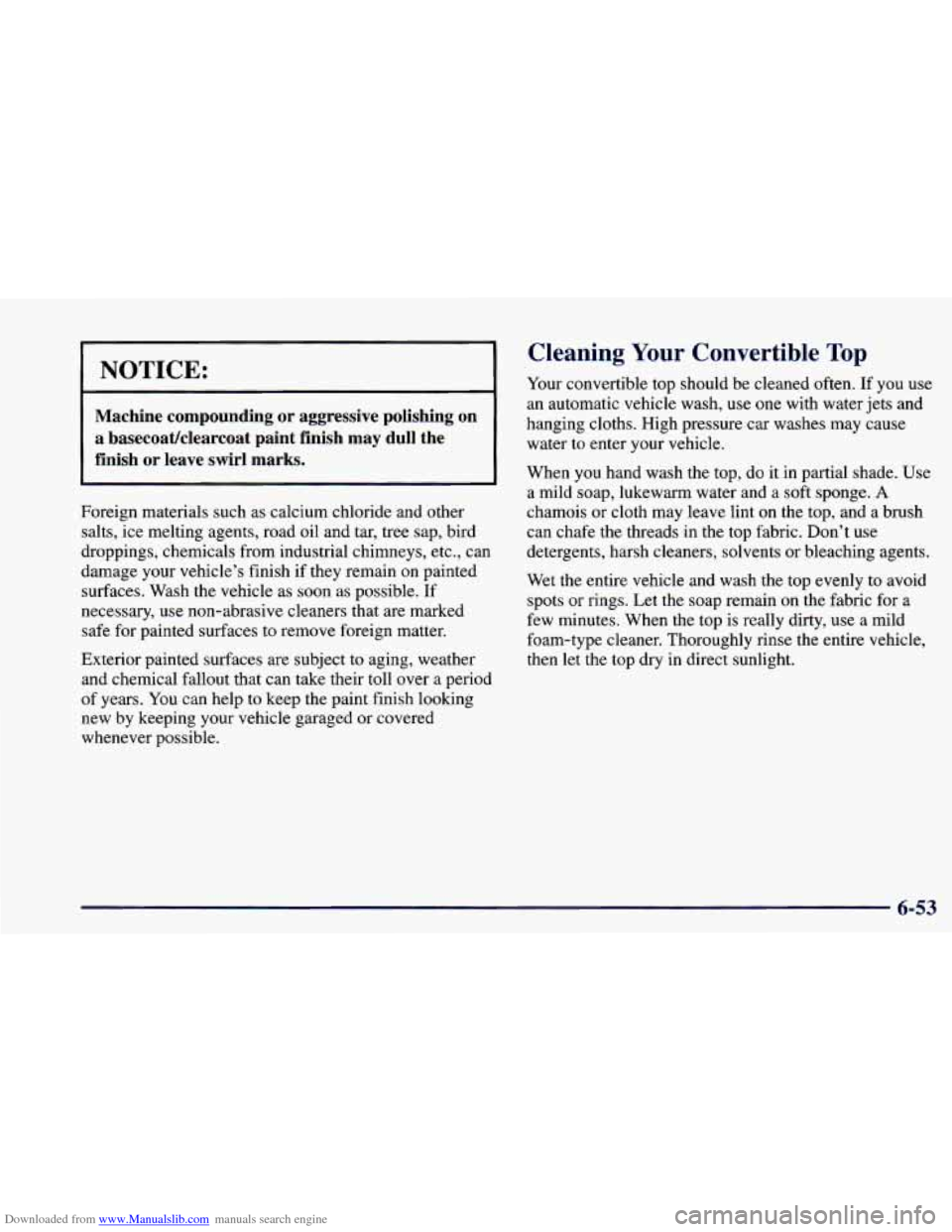
Downloaded from www.Manualslib.com manuals search engine NOTICE:
Cleaning Your Convertible Top
Your convertible top should be cleaned often. If you use
an automatic vehicle wash, use one with water jets and
hanging cloths. High pressure car washes may cause
When you hand wash the top, do it in partial shade. Use
a mild soap, lukewarm water and a soft sponge.
A
Machine compounding or aggressive polishing on
a basecoatklearcoat paint finish may dull the
water to enter your vehicle.
finish or leave swirl marks.
Foreign materials such as calcium chloride and other chamois or\
cloth may leave lint on the top, and a brush
salts, ice melting agents, road oil and tar, tree sap, bird can chafe the threads in the top fabric. Don’t use
droppings, chemicals from industrial chimneys, etc., can detergen\
ts, harsh cleaners, solvents or bleaching agents.
damage your vehicle’s finish if they remain on painted surfaces. Wash the vehicle as soon as possible. If
necessary, use non-abrasive cleaners that are marked safe for painted surfaces to remove foreign matter.
Exterior painted surfaces are subject to aging, weather and chemical fallout that can take their toll over a period
of years.
You can help to keep the paint finish looking
new
by keeping your vehicle garaged or covered
whenever possible. Wet
the entire vehicle and wash the top evenly to avoid
spots
or rings. Let the soap remain on the fabric for a
few minutes. When the top is really dirty, use a mild
foam-type cleaner. Thoroughly rinse the entire vehicle,
then let the top dry
in direct sunlight.
6-53
Page 312 of 400
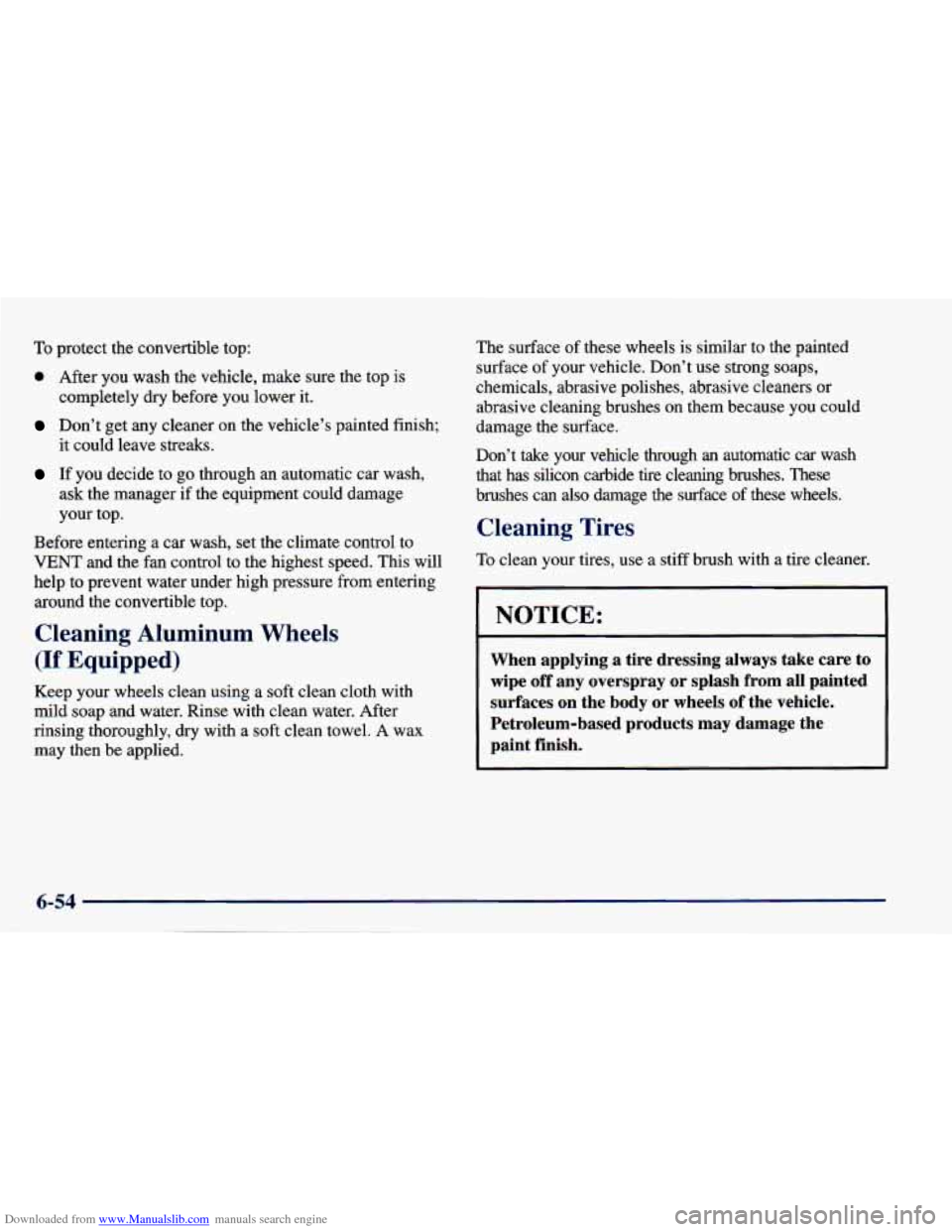
Downloaded from www.Manualslib.com manuals search engine To protect the convertible top:
0 After you wash the vehicle, make sure the top is
completely dry before you lower it.
Don’t get any cleaner on the vehicle’s painted finish;
it could leave streaks.
If you decide to go through an automatic car wash,
ask the manager if the equipment could damage
your top.
Before entering a car wash, set the climate control to
VENT and the fan control to the highest speed. This will
help to prevent water under high pressure from entering
around the convertible top.
Cleaning Aluminum Wheels
(If Equipped)
Keep your wheels clean using a soft clean cloth with
mild soap and water. Rinse with clean water. After
rinsing thoroughly, dry with a soft clean towel.
A wax
may then be applied. The surface
of these wheels is similar to the painted
surface
of your vehicle. Don’t use strong soaps,
chemicals, abrasive polishes, abrasive cleaners
or
abrasive cleaning brushes on them because you could
damage the surface.
Don’t take your vehicle through
an automatic car wash
that has silicon carbide tire cleaning brushes. These
brushes can also damage the surface of these wheels.
Cleaning T-- I
To clean your tires, ;e a stiff brush with a tire cleaner.
I- NOTICE:
When applying a tire dressing always take care to
wipe off any overspray
or splash from all painted
surfaces
on the body or wheels of the vehicle.
Petroleum-based products may damage the
paint finish.
Page 313 of 400
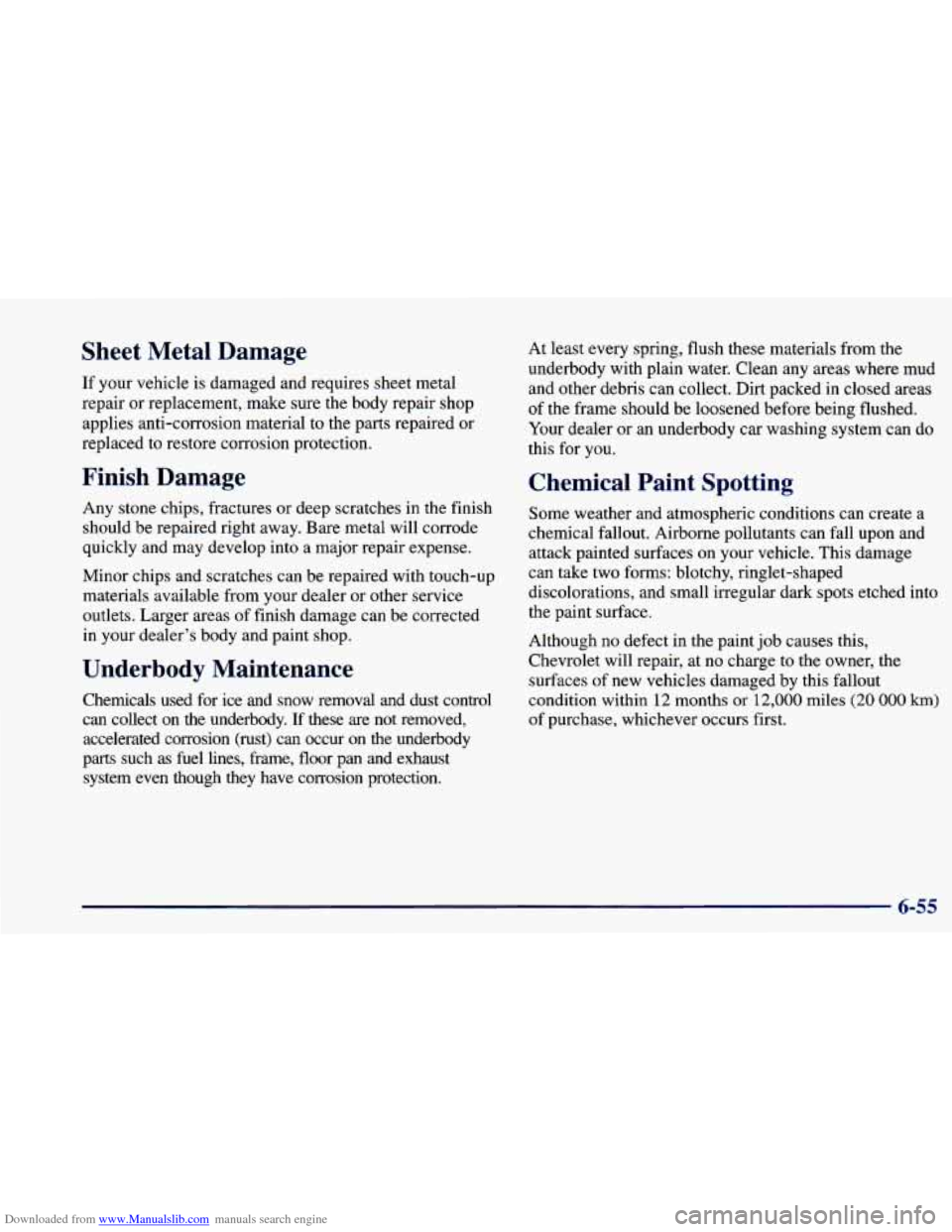
Downloaded from www.Manualslib.com manuals search engine Sheet Metal Damage
If your vehicle is damaged and requires sheet metal
repair or replacement, make sure the body repair shop
applies anti-corrosion material to the parts repaired or
replaced to restore corrosion protection.
Finish Damage
Any stone chips, fractures or deep scratches in the finish
should be repaired right away. Bare metal will corrode
quickly and may develop into a major repair expense.
Minor chips and scratches can be repaired with touch-up
materials available from your dealer or other service
outlets. Larger areas of finish damage can be corrected
in your dealer’s body and paint shop.
Underbody Maintenance
Chemicals used for ice and snow removal and dust control
can collect on the underbody. If these
are not removed,
accelerated corrosion (rust) can occur on
the underbody
parts such as
fuel lines, frame, floor pan and exhaust
system even though they have corrosion protection. At
least every spring, flush these materials from the
underbody with plain water. Clean any areas where mud
and other debris can collect. Dirt packed in closed
areas
of the frame should be loosened before being flushed.
Your dealer or an underbody car washing system can do
this for you.
Chemical Paint Spotting
Some weather and atmospheric conditions can create a
chemical fallout. Airborne pollutants can fall upon and
attack painted surfaces on your vehicle. This damage
can take two forms: blotchy, ringlet-shaped
discolorations, and small irregular dark spots etched into
the paint surface.
Although no defect
in the paint job causes this,
Chevrolet will repair, at no charge to the owner, the
surfaces of new vehicles damaged by this fallout
condition within
12 months or
of purchase, whichever occurs
12,000 miles (20 000 km)
first.
6-55
Page 314 of 400
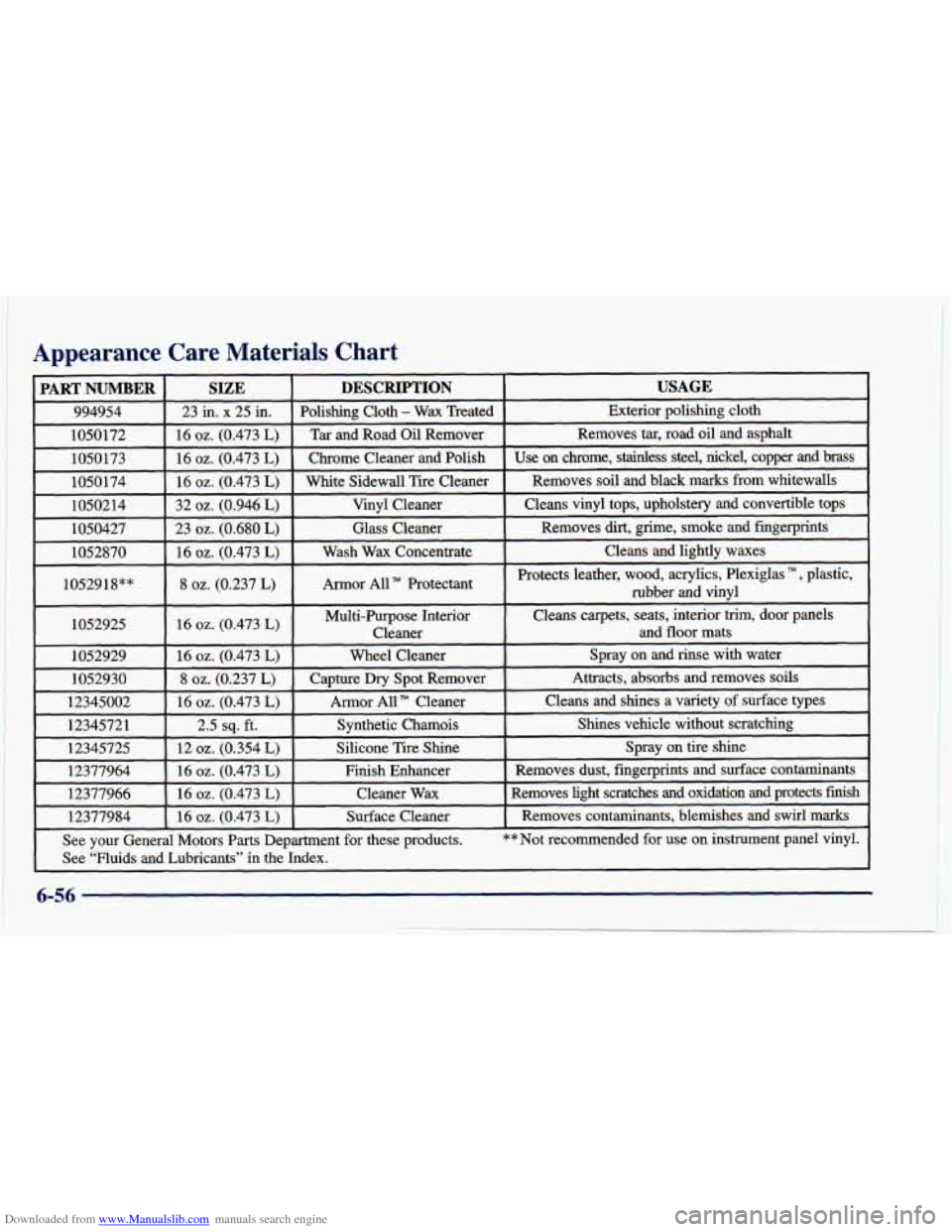
Downloaded from www.Manualslib.com manuals search engine Appearance Care Materials Chart
6-56
Page 315 of 400
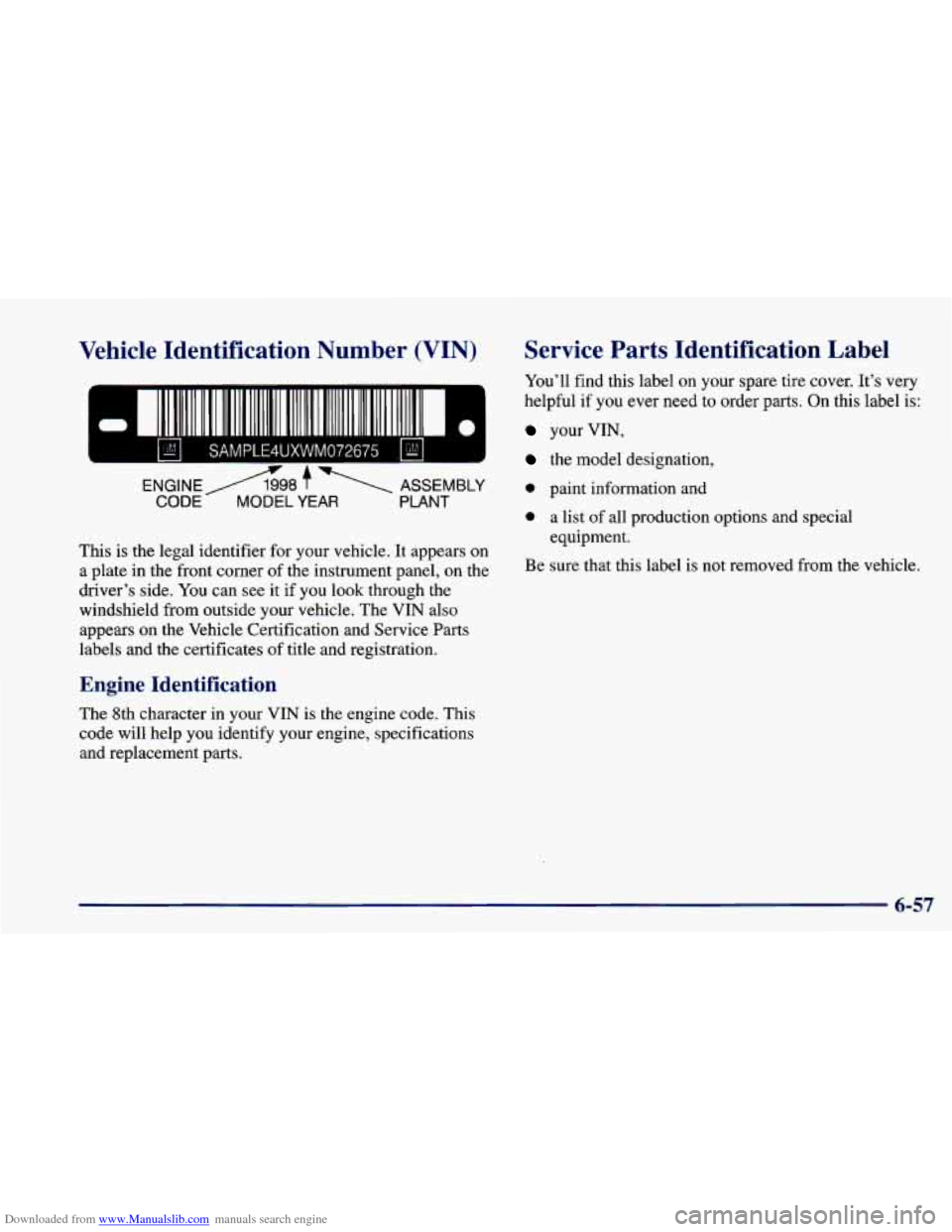
Downloaded from www.Manualslib.com manuals search engine Vehicle Identification Number (VIN)
SAMPLE4UXWM072675 bd
This is the legal identifier for your vehicle. It appears on
a plate in the front corner of the instrument panel, on the
driver’s side.
You can see it if you look through the
windshield from outside your vehicle. The VIN also
appears on the Vehicle Certification and Service Parts
labels and the certificates of title and registration.
Engine Identification
The 8th character in your VIN is the engine code. This
code will help
you identify your engine, specifications
and replacement parts.
Service Parts Identification Label
You’ll find this label on your spare tire cover. It’s ve\
ry
helpful
if you ever need to order parts. On this label is:
your VIN,
the model designation,
0 paint information and
0 a list of all production options and special
Be sure that this label is not removed from the vehicle. equipment.
6-57
Page 316 of 400
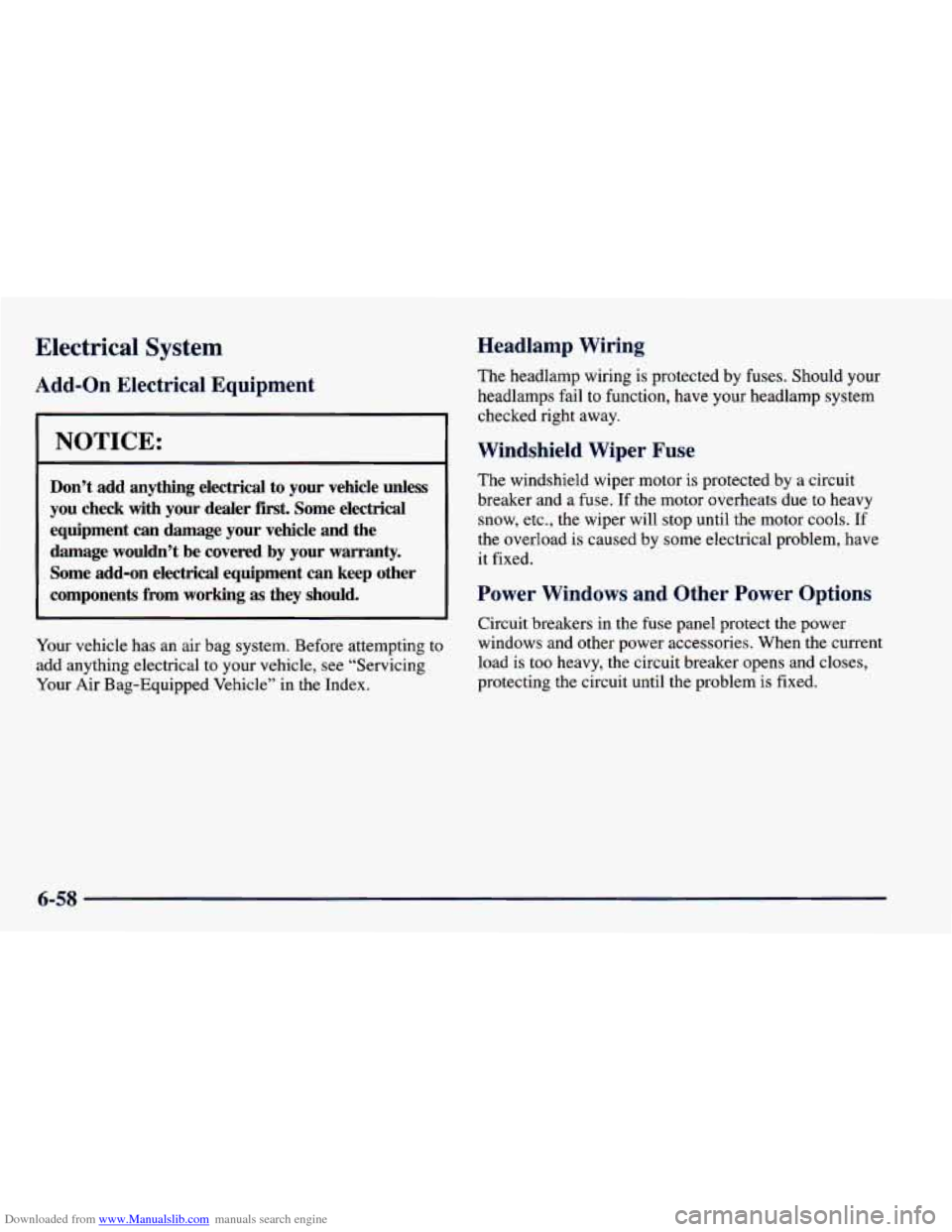
Downloaded from www.Manualslib.com manuals search engine Electrical System
Add-on Electrical Equipment
NOTICE:
Don’t add anything electrical to your vehicle unless
you check
with your dealer first. Some electrical
equipment can damage your vehicle and the
damage wouldn’t be covered
by your warranty.
Some add-on electrical equipment
can keep other
components
from working as they should.
Your vehicle has an air bag system. Before attempting to
add anything electrical to your vehicle, see “Servicing
Your Air Bag-Equipped Vehicle” in the Index.
Headlamp Wiring
The headlamp wiring is protected by fuses. Should your
headlamps fail
to function, have your headlamp system
checked right away.
Windshield Wiper Fuse
The windshield wiper motor is protected by a circuit
breaker and a fuse. If the motor overheats due
to heavy
snow, etc., the wiper will stop until the motor cools. If
the overload is caused by some electrical problem, have
it fixed.
Power Windows and Other Power Options
Circuit breakers in the fuse panel protect the power
windows and other power accessories. When the current
load is too heavy, the circuit breaker opens and closes,
protecting the circuit until the problem is fixed.
6-58
Page 317 of 400
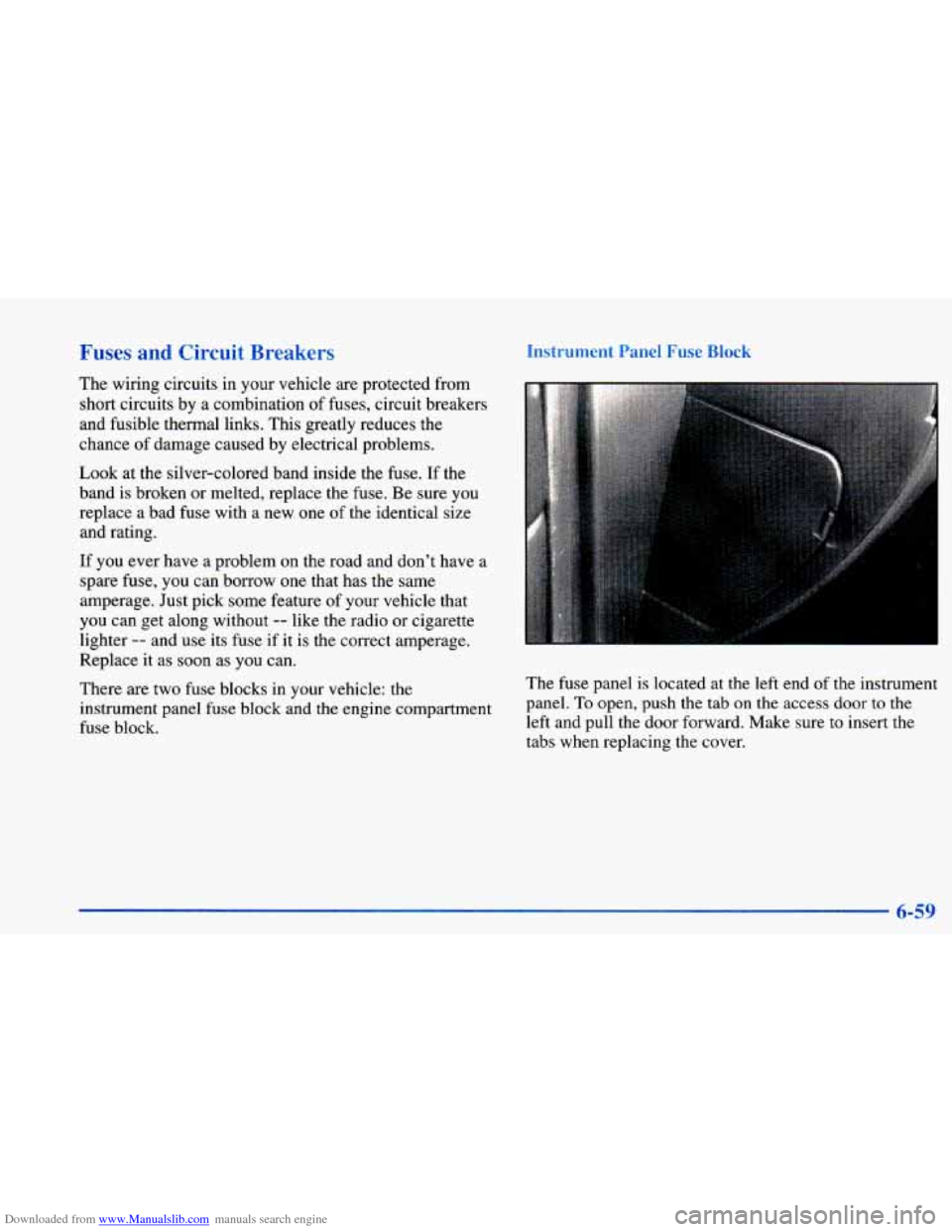
Downloaded from www.Manualslib.com manuals search engine Fuses and Circuit Breakers
The wiring circuits in your vehicle are protected from
short circuits by a combination of fuses, circuit breakers
and fusible thermal links. This greatly reduces the
chance of damage caused by electrical problems.
Look at the silver-colored band inside the fuse. If the
band is broken or melted, replace the fuse.
Be sure you
replace a bad fuse with a new one of the identical size
and rating.
If you ever have a problem on the road and don’t have a
spare fuse, you can borrow one that has the same
amperage. Just pick some feature of your vehicle that
you can get along without
-- like the radio or cigarette
lighter
-- and use its fuse if it is the correct amperage.
Replace it as soon
as you can.
There are two fuse blocks in your vehicle: the
instrument panel
fuse block and the engine compartment
fuse block.
Instrument Panel Fuse Block
The fuse panel is located at the left end of the instrument
panel.
To open, push the tab on the access door to the
left and pull the door forward.
Make sure to insert the
tabs when replacing the cover.
6-59
Page 318 of 400
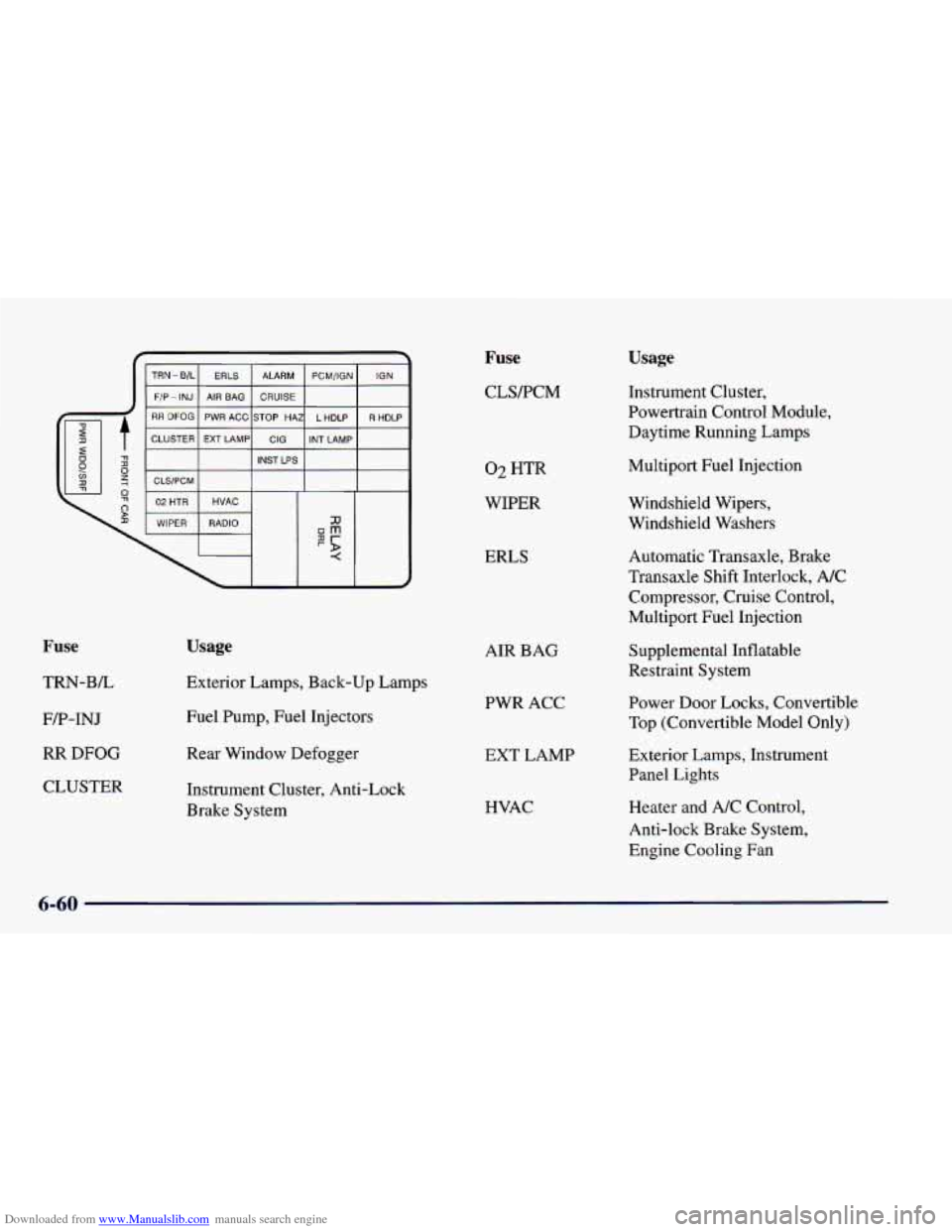
Downloaded from www.Manualslib.com manuals search engine Fuse
TRN-BL FA'-INJ
RR DFOG
CLUSTER
Usage
Exterior Lamps, Back-up Lamps
Fuel Pump, Fuel Injectors
Rear Window Defogger
Instrument Cluster, Anti-Lock
Brake System
Fuse
CLSRCM
02 HTR
WIPER
ERLS
AIR BAG
PWR ACC
EXT LAMP
HVAC
Usage
Instrument Cluster,
Powertrain Control Module,
Daytime Running Lamps
Multiport Fuel Injection
Windshield Wipers,
Windshield Washers Automatic Transaxle, Brake
Transaxle Shift Interlock, A/C
Compressor, Cruise Control,
Multiport Fuel Injection
Supplemental Inflatable
Restraint System
Power Door Locks, Convertible
Top (Convertible Model Only)
Exterior Lamps, Instrument
Panel Lights
Heater and A/C Control,
Anti-lock Brake System,
Engine Cooling Fan
6-60
Page 319 of 400
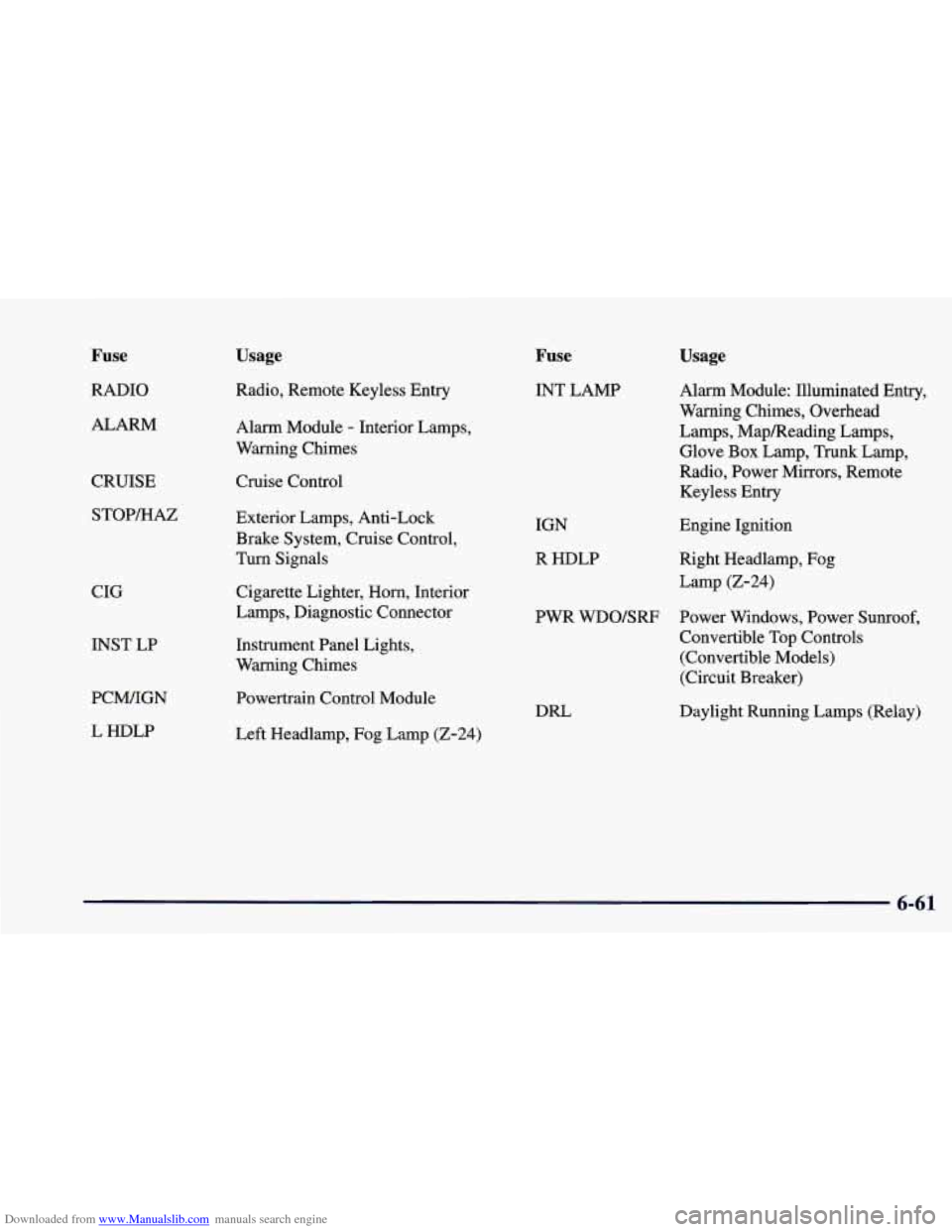
Downloaded from www.Manualslib.com manuals search engine Fuse
RADIO
ALARM CRUISE STOP/HAZ
CIG
INST LP
PCM/IGN
L HDLP
Usage
Radio, Remote Keyless Entry
Alarm Module
- Interior Lamps,
Warning Chimes
Cruise Control
Exterior Lamps, Anti-Lock
Brake System, Cruise Control,
Turn Signals Cigarette Lighter,
Horn, Interior
Lamps, Diagnostic Connector
Instrument Panel Lights,
Warning Chimes
Powertrain Control Module
Left Headlamp, Fog Lamp
(2-24)
Fuse
INT LAMP
IGN
R HDLP
Usage
Alarm Module: Illuminated Entry,
Warning Chimes, Overhead
Lamps, MapReading Lamps,
Glove Box Lamp, Trunk Lamp,
Radio, Power Mirrors, Remote Keyless
Entry
Engine Ignition
Right Headlamp, Fog
Lamp
(2-24)
PWR WDO/SRF Power Windows, Power Sunroof,
Convertible Top Controls
(Convertible Models)
(Circuit Breaker)
DRL Daylight Running Lamps (Relay)
6-61
Page 320 of 400
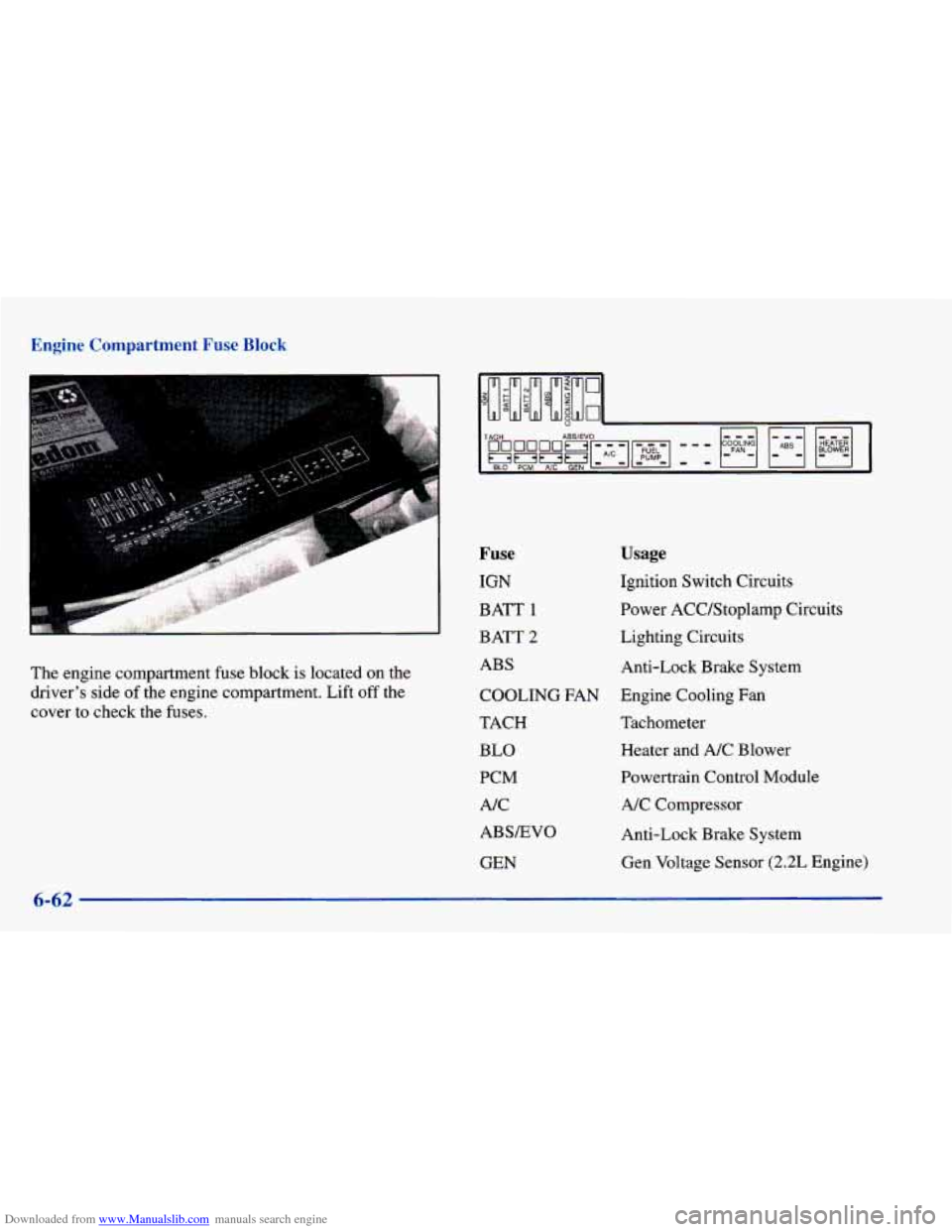
Downloaded from www.Manualslib.com manuals search engine Engine Compartment Fuse Block
The engine compartment fuse block is located on the
driver’s side
of the engine compartment. Lift off the
cover to check the fuses.
Fuse
IGN
BATT 1
BATT 2
ABS
COOLING FAN
TACH
BLO
PCM AIC
ABSEVO
GEN
Usage
Ignition Switch Circuits
Power ACC/Stoplamp Circuits
Lighting Circuits
Anti-Lock Brake System
Engine Cooling Fan
Tachometer
Heater and
A/C Blower
Powertrain Control Module
A/C Compressor
Anti-Lock Brake System
Gen Voltage Sensor (2.2L Engine)
6-62